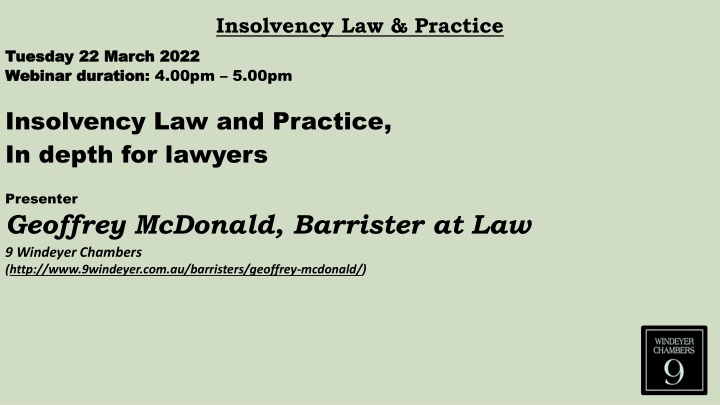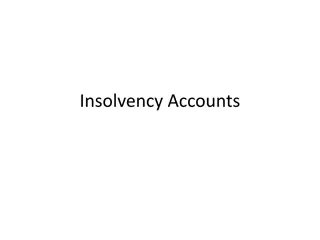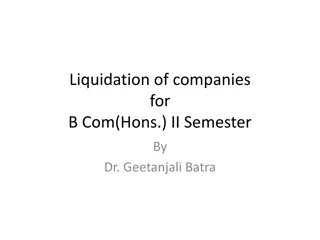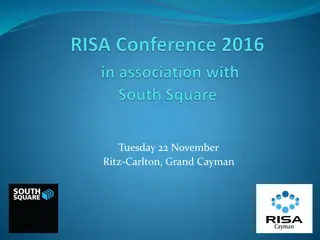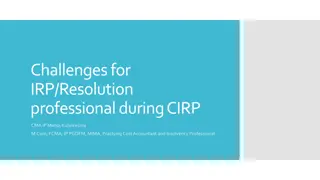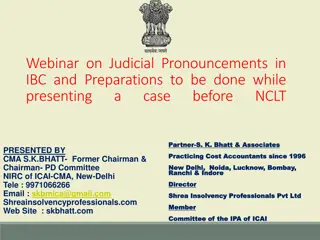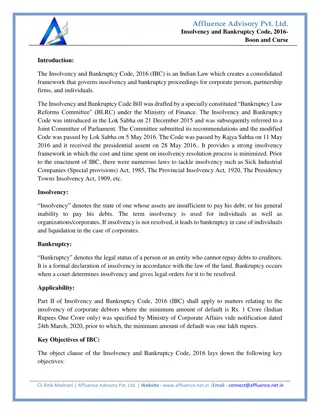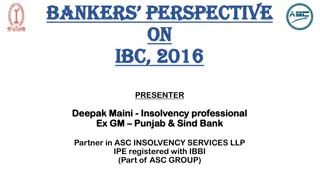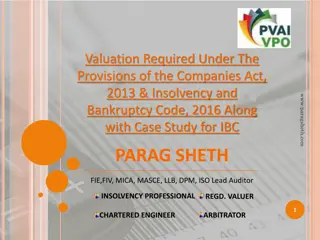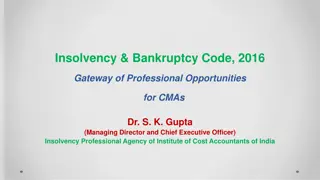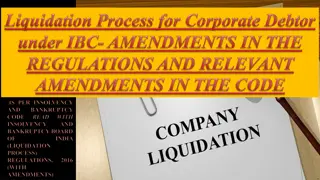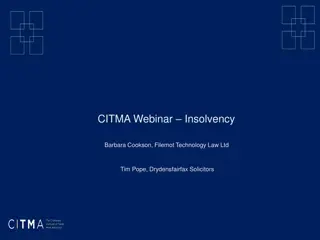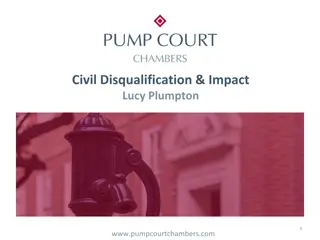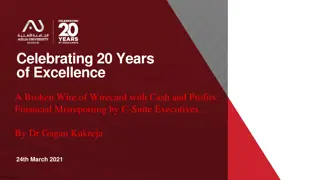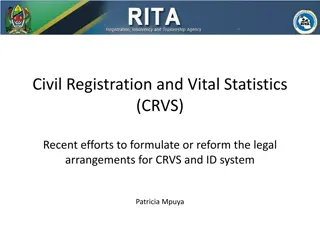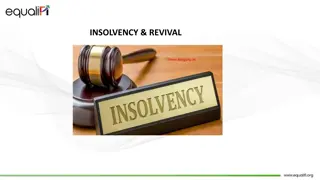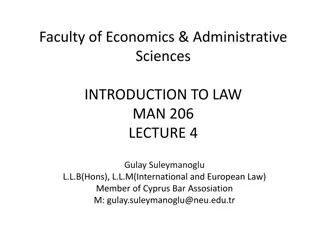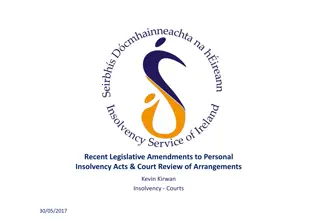Insight into Insolvency Law & Practice: Webinar Overview
Delve into a comprehensive webinar on Insolvency Law and Practice featuring Geoffrey McDonald, a seasoned Barrister at Law. The session covers various aspects including Insolvency and Taxes, Statutory Demands, Winding-up Applications, Liquidations, Insolvent Trading, and more. Discover key statistics, trends, and insights in the realm of insolvency law and get valuable resources for future reference. Engage with the presenter and explore critical topics in the domain of insolvency.
Download Presentation

Please find below an Image/Link to download the presentation.
The content on the website is provided AS IS for your information and personal use only. It may not be sold, licensed, or shared on other websites without obtaining consent from the author.If you encounter any issues during the download, it is possible that the publisher has removed the file from their server.
You are allowed to download the files provided on this website for personal or commercial use, subject to the condition that they are used lawfully. All files are the property of their respective owners.
The content on the website is provided AS IS for your information and personal use only. It may not be sold, licensed, or shared on other websites without obtaining consent from the author.
E N D
Presentation Transcript
Insolvency Law & Practice Tuesday 22 March 2022 Tuesday 22 March 2022 Webinar duration Webinar duration: 4.00pm 5.00pm Insolvency Law and Practice, In depth for lawyers Presenter Geoffrey McDonald, Barrister at Law 9 Windeyer Chambers (http://www.9windeyer.com.au/barristers/geoffrey-mcdonald/)
Insolvency Law & Practice Disclaimer; Disclaimer; this presentation and these papers are not legal advice! this presentation and these papers are not legal advice! Web site for Papers: https://www.9windeyer.com.au/barristers/geoffrey-mcdonald/ Past papers by Geoffrey McDonald: link at List.docx (google.com) Due to the relatively short duration of this Webinar, you will find that the presentation will bring Due to the relatively short duration of this Webinar, you will find that the presentation will bring issues to your attention, rather than answer all the questions and the PowerPoint paper and the issues to your attention, rather than answer all the questions and the PowerPoint paper and the Webinar Video will be a helpful resource for future guidance (both soon to be posted on the 9 Webinar Video will be a helpful resource for future guidance (both soon to be posted on the 9 Windeyer Website). Windeyer Website). You are invited to ask questions You are invited to ask questions after the Webinar after the Webinar by emailing gmcdonald@windeyerchambers.com.au gmcdonald@windeyerchambers.com.au by emailing
Insolvency Law & Practice Outline; 1. Insolvency and Taxes 2. Statutory Demands and Bankruptcy Notices 3. Winding up applications and Creditor s Petition 4. Small Business Restructuring Plans/Practitioners/Proposals and Simplified Liquidations 5. Insolvent trading 6. Liquidator examinations 7. Phoenix Companies and Untrustworthy Advisors 8. Director resignations 9. Director Penalty Notices 10.Developments re Preferences 11.Law re insolvent corporate trustee 12.Conflict of Interest 13.Director related transactions 14.Administration Orders 15.Other changes
Insolvency Law & Practice 1. Insolvency and Taxes Total personal insolvencies fell by 49.6% in 2020 21 compared to 2019 20. By type of personal insolvency: bankruptcies fell by 46.7% debt agreements fell by 54.2% personal insolvency agreements fell by 46.7% (there were 89 personal insolvency agreements in Australia in 2020 21) https://www.afsa.gov.au/about-us/statistics Annual statistics for 2020 21 Companies entering external administration and controller appointments 2019-2020 10,063 2020-2021 6,027 (SBRP 12, Plans 6)(Simp Liq 23) https://asic.gov.au/regulatory-resources/find-a-document/statistics/insolvency-statistics/insolvency-statistics-series-2-external-administration-and-controller-appointments/
Insolvency Law & Practice 1. Insolvency and Taxes Collectable debt levels reported by the ATO have grown from $19.2 billion in financial year 2016, to more than $34.1 billion in financial year 2020. It has also been reported that the Australian Taxation Office's (ATO) business debt has doubled It has also been reported that the Australian Taxation Office's (ATO) business debt has doubled from $24.9 billion (30 June 2020) to a colossal $53.8 billion (30 June 2021), with that data being from $24.9 billion (30 June 2020) to a colossal $53.8 billion (30 June 2021), with that data being nine months old. nine months old. Typically, the ATO applies to wind up an average 100 companies a month, but applications Typically, the ATO applies to wind up an average 100 companies a month, but applications were abandoned during the COVID were abandoned during the COVID- -19 period. 19 period. The Australian Tax Office has resumed chasing debts in Victoria, New South Wales and the The Australian Tax Office has resumed chasing debts in Victoria, New South Wales and the ACT following a temporary pause as residents braved COVID ACT following a temporary pause as residents braved COVID- -19 lockdowns. 19 lockdowns. In a statement to In a statement to 7NEWS.com.au resumed with penalties for non resumed with penalties for non- -compliance expected to be more noticeable in the three compliance expected to be more noticeable in the three jurisdictions. jurisdictions. 7NEWS.com.au, an ATO spokesperson confirmed all enforcement actions had , an ATO spokesperson confirmed all enforcement actions had Nov 2021
Insolvency Laws 2. 2. Statutory Demands and Bankruptcy Notices For the period from For the period from 24 March 2020 to 31 December 2020, the insolvency laws were changed to 24 March 2020 to 31 December 2020, the insolvency laws were changed to; ; Increase the current minimum threshold for creditors issuing a Increase the current minimum threshold for creditors issuing a statutory demand company under the Corporations Act 2001 from $2,000 to $ company under the Corporations Act 2001 from $2,000 to $20,000 Extend the statutory timeframe for a company to respond to a statutory demand from 21 days Extend the statutory timeframe for a company to respond to a statutory demand from 21 days to to six months six months. . Increase the threshold for the minimum amount of debt required for a creditor to Increase the threshold for the minimum amount of debt required for a creditor to initiate bankruptcy proceedings bankruptcy proceedings from its current level of $5,000 to $20,000. from its current level of $5,000 to $20,000. Increase the time a debtor has to respond to a Increase the time a debtor has to respond to a bankruptcy notice Corporations Amendment (Corporate Insolvency Reforms) Act 2020 Corporations Amendment (Corporate Insolvency Reforms) Act 2020 Extended in September 2020 to 31 December 2021 Extended in September 2020 to 31 December 2021 statutory demand on a 20,000. . on a initiate bankruptcy notice from 21 days to from 21 days to six months six months. .
Insolvency Laws 2. 2. Statutory Demands and Bankruptcy Notices The threshold for a creditor to issue a statutory demand is $4,000, as from 1 July 2021. The threshold for a creditor to issue Bankruptcy Notice is $10,000, as from 1 January 2021 (also Creditor s Petition) s. 44 Conditions on which creditor may petition s. 44 Conditions on which creditor may petition (1) A creditor's petition shall not be presented against a debtor unless: (1) A creditor's petition shall not be presented against a debtor unless: (a) there is owing by the debtor to the petitioning creditor a debt that amounts to the statutory minimum (a) there is owing by the debtor to the petitioning creditor a debt that amounts to the statutory minimum (c) the act of bankruptcy on which the petition is founded was committed within 6 months before the presentation of the peti (c) the act of bankruptcy on which the petition is founded was committed within 6 months before the presentation of the petiti tion. on.
Insolvency Laws 3. Winding up applications and Creditor s Petition Links below Links below Bankruptcy Information Sheet 1: Presenting a creditor's petition (fedcourt.gov.au) Bankruptcy Information Sheet 2: Creditor's petition checklist (fedcourt.gov.au) Bankruptcy Information Sheet 3: Opposing a creditor's petition (fedcourt.gov.au) Bankruptcy Information Sheet 4: Setting aside a bankruptcy notice (fedcourt.gov.au) Bankruptcy Information Sheet 5: Substituted service applications (fedcourt.gov.au) Updated January 2021 Corporations Information Sheet 1: Winding up proceedings based on an unsatisfied Statutory Demand (fedcourt.gov.au) Corporations Information Sheet 2: Winding up checklist (fedcourt.gov.au) Also, Scale of Fees for winding up (note NSWSC applies FCA by protocol) 13.1 Short form amount that may be claimed by a plaintiff on the making of a winding-up order or on the dismissal of such an application, up to and including entry and service of the order under section 470 of the Corporations Act 2001 and the obtaining of a certificate of taxation: $4,230 (plus proven disbursements)
Insolvency Laws 3. 3. Bankruptcy Regulations 2021 (Regulation 102) commenced on 1 April 2021 commenced on 1 April 2021 16.01 16.01 Service of documents Service of documents Bankruptcy Regulations 1996 (1) Unless the contrary intention appears, where a document is required or permitted by the Act or these Regulations to be given or sent to, or served on, a person (other than a person mentioned in regulation 16.02), the document may be: (a) sent by post, or by a courier service, to the person at his or her last-known address; or (b) left, in an envelope or similar packaging marked with the person s name and any relevant document exchange number, at a document exchange where the person maintains a document exchange facility; or (c) left, in an envelope or similar packaging marked with the person s name, at the last-known address of the person; or (d) personally delivered to the person; or (e) sent by facsimile transmission or another mode of electronic transmission: (i) to a facility maintained by the person for receipt of electronically transmitted documents; or (ii) in such a manner (for example, by electronic mail) that the document should, in the ordinary course of events, be received by the person.
Insolvency Laws 3. 3. Creditor s Petition; Bankruptcy Regulations 2021 ACTS INTERPRETATION ACT 1901 ACTS INTERPRETATION ACT 1901 - - SECT 28A Service of documents Service of documents (1) For the purposes of any Act that requires or permits a document to be (1) For the purposes of any Act that requires or permits a document to be served on a person, whether the expression "serve", "give" or "send" or any other served on a person, whether the expression "serve", "give" or "send" or any other expression is used, then the document may be served: expression is used, then the document may be served: (a) on a natural person: (a) on a natural person: ( (i i) ) by delivering it to the person personally; or by delivering it to the person personally; or (ii) by leaving it at, or by sending it by pre (ii) by leaving it at, or by sending it by pre- -paid post to, the address of the place of residence or business of the person last known to the person serving of the place of residence or business of the person last known to the person serving the document the document SECT 28A paid post to, the address s 9 of the Electronic Transactions Act 1999 s 9 of the Electronic Transactions Act 1999 For Companies; Corporations Act section 109X For Companies; Corporations Act section 109X
Insolvency Laws 3. 3. Creditor s Petition; The lawyers for the creditor had emailed the bankruptcy notice to the The lawyers for the creditor had emailed the bankruptcy notice to the debtor s address and the creditor s petition was later served in the same manner. address and the creditor s petition was later served in the same manner. debtor s email email 11. The manner in which Bankruptcy Notices can be served is set out in the following: 11. The manner in which Bankruptcy Notices can be served is set out in the following: Regulation 102 of the Bankruptcy Regulations 2021 ( Regulation 102 of the Bankruptcy Regulations 2021 (Cth Section 28A of the Acts Interpretation Act 1901 ( Section 28A of the Acts Interpretation Act 1901 (Cth Section 9 of the Electronic Transactions Act 1999 ( Section 9 of the Electronic Transactions Act 1999 (Cth Cth); ); ); and Cth). ). Cth); and The debtor The debtor had replied by email to the creditor s lawyer s email and had replied by email to the creditor s lawyer s email and deposed I was served with the Bankruptcy Notice which was served on me on 19 May 2021 . The served with the Bankruptcy Notice which was served on me on 19 May 2021 . The Court found that these laws require a debtor to first consent to be served by email. Court found that these laws require a debtor to first consent to be served by email. deposed I was 22. It is well established that actual receipt of a Bankruptcy Notice does not permit s 22. It is well established that actual receipt of a Bankruptcy Notice does not permit s 306 to cure the irregularity in strict service of Bankruptcy Notices. First, the 306 to cure the irregularity in strict service of Bankruptcy Notices. First, the need for strict compliance cannot be waived by the debtor. Second, the need for strict compliance cannot be waived by the debtor. Second, the position is different in relation to Creditor s Petitions, but not Bankruptcy position is different in relation to Creditor s Petitions, but not Bankruptcy Notices. Notices. Pegios Pegios in his own capacity and as trustee for in his own capacity and as trustee for Pegios Pegios Superannuation Fund v Superannuation Fund v Arambasic Arambasic [2022] FedCFamC2G 17. [2022] FedCFamC2G 17.
Insolvency Laws 3. 3. Creditor s Petition; Set aside v Annulment (on review of Registrar Decision) Samsakopoulos Samsakopoulos v Body Corporate for Sanderling at Kings Beach CTS 2942 [2021] FCAFC 143 v Body Corporate for Sanderling at Kings Beach CTS 2942 [2021] FCAFC 143 http://www.austlii.edu.au/cgi http://www.austlii.edu.au/cgi- -bin/viewdoc/au/cases/cth/FCAFC/2021/143.html bin/viewdoc/au/cases/cth/FCAFC/2021/143.html 1 November 2018, made bankrupt by order of the Registrar 1 November 2018, made bankrupt by order of the Registrar 14 April 2019, applied to review the Registrar s decision 14 April 2019, applied to review the Registrar s decision 17 July 2019, 17 July 2019, Registrar s Registrar s decision set aside and the Creditor s Petition be decision set aside and the Creditor s Petition be dismissed. dismissed. The Trustee appeared, but made no submissions regarding his costs or The Trustee appeared, but made no submissions regarding his costs or the alternative of annulment under s153B (relying on the alternative of annulment under s153B (relying on Pattison v (2006) 155 FCR 226) (2006) 155 FCR 226) http://www.austlii.edu.au/cgi 11 December 2019, Trustee applied for approval of his remuneration/costs and an 11 December 2019, Trustee applied for approval of his remuneration/costs and an order that they be paid by either the ex order that they be paid by either the ex- -bankrupt or the creditor bankrupt or the creditor 15 July 2020, the Court dismissed that application, on the basis that s.104(3) of the 15 July 2020, the Court dismissed that application, on the basis that s.104(3) of the FCCA Act was not wide enough to support the making of an order in the trustee s FCCA Act was not wide enough to support the making of an order in the trustee s favour for his remuneration, costs and expenses. favour for his remuneration, costs and expenses. http://www.austlii.edu.au/cgi bin/viewdoc/au/cases/cth/FCCA/2020/1909.html bin/viewdoc/au/cases/cth/FCCA/2020/1909.html Pattison v Hadjimouratis Hadjimouratis http://www.austlii.edu.au/cgi- -bin/viewdoc/au/cases/cth/FCCA/2019/2133.html bin/viewdoc/au/cases/cth/FCCA/2019/2133.html http://www.austlii.edu.au/cgi- - The Full Court, constituted by 5 Judges, allowed the appeal and ordered The Full Court, constituted by 5 Judges, allowed the appeal and ordered
Insolvency Laws 3. 3. Creditor s Petition; Set aside v Annulment (on review) ORDERS ORDERS 1. There be leave to the applicant to appeal. 1. There be leave to the applicant to appeal. 2. 2. The appeal is allowed. The appeal is allowed. 3. The orders of the Federal Circuit Court made on 11 December 2019 are set 3. The orders of the Federal Circuit Court made on 11 December 2019 are set aside and in lieu thereof it is aside and in lieu thereof it is ordered pursuant to s 104(3) of the Federal Circuit Court ordered pursuant to s 104(3) of the Federal Circuit Court of Australia Act 1999 ( of Australia Act 1999 (Cth Cth) ) that the following orders be made consequent upon the that the following orders be made consequent upon the order made by the Federal Circuit Court on 17 July 2019 that the creditor's petition order made by the Federal Circuit Court on 17 July 2019 that the creditor's petition filed on 30 July 2018 be dismissed (Dismissal Order): filed on 30 July 2018 be dismissed (Dismissal Order): (a) (a) the petitioning creditor do pay the reasonable remuneration of Mr William the petitioning creditor do pay the reasonable remuneration of Mr William Roland Robson in administering the estate of Ms Victoria Roland Robson in administering the estate of Ms Victoria Samsakopoulos the orders made by a registrar of the Federal Circuit Court exercising delegated the orders made by a registrar of the Federal Circuit Court exercising delegated judicial power (Administration) which orders ceased to have effect on 17 July 2019, judicial power (Administration) which orders ceased to have effect on 17 July 2019, such remuneration to be capped in the amount of $30,000 plus GST; such remuneration to be capped in the amount of $30,000 plus GST; (b) the petitioning creditor do pay the (b) the petitioning creditor do pay the costs and expenses costs and expenses reasonably and properly incurred by Mr Robson in the Administration prior to 17 July 2019; properly incurred by Mr Robson in the Administration prior to 17 July 2019; (c) there be (c) there be no order as to the remuneration, costs and expenses incurred by Mr no order as to the remuneration, costs and expenses incurred by Mr Robson in respect of the Administration on or after 17 July 2019 Robson in respect of the Administration on or after 17 July 2019; ; Samsakopoulos pursuant to pursuant to reasonably and
Insolvency Laws 3. 3. Creditor s Petition; Set aside v Annulment (on review) (d) to the extent necessary, (d) to the extent necessary, all acts do when acting as trustee pursuant to the sequestration order made on 1 November when acting as trustee pursuant to the sequestration order made on 1 November 2018 or any person acting under the authority of Mr Robson when acting pursuant to 2018 or any person acting under the authority of Mr Robson when acting pursuant to the order the order are taken to have been validly done; are taken to have been validly done; (e) to the extent necessary and to the extent possible without further order, all (e) to the extent necessary and to the extent possible without further order, all property that vested property that vested in Mr Robson when acting as trustee pursuant to the in Mr Robson when acting as trustee pursuant to the sequestration order made on 1 November 2018 sequestration order made on 1 November 2018 that has not been returned to Ms Samsakopoulos Samsakopoulos shall vest immediately in Ms shall vest immediately in Ms Samsakopoulos (f) there be liberty to Mr Robson to apply for such further orders as may be (f) there be liberty to Mr Robson to apply for such further orders as may be reasonably necessary to ensure that all property that vested in Mr Robson when reasonably necessary to ensure that all property that vested in Mr Robson when acting as trustee pursuant to the sequestration order made on 1 November 2018 is acting as trustee pursuant to the sequestration order made on 1 November 2018 is vested in Ms vested in Ms Samsakopoulos Samsakopoulos and as soon as reasonably possible Mr Robson do apply and as soon as reasonably possible Mr Robson do apply pursuant to such liberty for such orders as may be reasonably necessary to vest the pursuant to such liberty for such orders as may be reasonably necessary to vest the property in Ms property in Ms Samsakopoulos Samsakopoulos; ; (g) (g) Mr Robson shall do all things as may be reasonably necessary to Mr Robson shall do all things as may be reasonably necessary to give effect to order (e) and any orders made pursuant to order (f); give effect to order (e) and any orders made pursuant to order (f); all acts done prior to 17 July 2019 by Mr Robson ne prior to 17 July 2019 by Mr Robson that has not been returned to Ms Samsakopoulos; ;
Insolvency Laws 3. 3. Creditor s Petition; Set aside v Annulment (on review) (h) the (h) the petitioning creditor shall not by any means seek to recover petitioning creditor shall not by any means seek to recover any contribution from Ms contribution from Ms Samsakopoulos Samsakopoulos in respect of any amount that the petitioning in respect of any amount that the petitioning creditor is liable or becomes liable to pay pursuant to these orders; creditor is liable or becomes liable to pay pursuant to these orders; ( (i i) it is ) it is declared that Ms declared that Ms Samsakopoulos Samsakopoulos shall not have the status of a former bankrupt; bankrupt; (j) there be no orders as to the costs of the application filed on 11 December (j) there be no orders as to the costs of the application filed on 11 December 2019; and 2019; and (k) there be liberty to apply for any further consequential orders. (k) there be liberty to apply for any further consequential orders. 4. 4. The appellant and first respondent shall each bear their own costs of the The appellant and first respondent shall each bear their own costs of the appeal. appeal. 5. On or before 2 September 2021, the appellant do file and serve an affidavit 5. On or before 2 September 2021, the appellant do file and serve an affidavit providing any providing any explanation as to why the appellant failed to promptly give effect to the explanation as to why the appellant failed to promptly give effect to the Dismissal Order Dismissal Order and do show cause by affidavit and any submissions as to any reason and do show cause by affidavit and any submissions as to any reason why the Court should not why the Court should not appoint a registrar as a referee to inquire into the extent appoint a registrar as a referee to inquire into the extent to which the failure by Mr Robson to promptly give effect to the Dismissal Order has which the failure by Mr Robson to promptly give effect to the Dismissal Order has caused loss or damage to Ms caused loss or damage to Ms Samsakopoulos Samsakopoulos for the purpose of the Court formulating such further consequential orders pursuant to s 104(3) of the Federal Circuit Court of such further consequential orders pursuant to s 104(3) of the Federal Circuit Court of Australia Act as may be appropriate in the circumstances which have occurred. Australia Act as may be appropriate in the circumstances which have occurred. any shall not have the status of a former to for the purpose of the Court formulating
Insolvency Laws 3. 3. Creditor s Petition; Set aside v Annulment (on review of Registrar Decision) Robson v Body Corporate for Sanderling at Kings Beach Robson v Body Corporate for Sanderling at Kings Beach (No 2) (No 2) [2021] FCAFC 190 [2021] FCAFC 190 4. During the hearing of the appeal it became clear that 4. During the hearing of the appeal it became clear that Mr Robson had retained possession of the property of Ms possession of the property of Ms Samsakopoulos Samsakopoulos pending the outcome of the proceedings. This course was not supported by any order of the Court nor by any proceedings. This course was not supported by any order of the Court nor by any provision of the Bankruptcy Act 1966 ( provision of the Bankruptcy Act 1966 (Cth Cth). It was, in effect, help remedy help remedy in circumstances where Mr Robson had failed in his application to the in circumstances where Mr Robson had failed in his application to the Circuit Court and sought orders in the appeal that would have seen payment of his Circuit Court and sought orders in the appeal that would have seen payment of his remuneration and the costs and expenses of the nullified administration out of the remuneration and the costs and expenses of the nullified administration out of the property of Ms property of Ms Samsakopoulos Samsakopoulos. In consequence, Ms . In consequence, Ms Samsakopoulos her property for a considerable period of time by Mr Robson without any legal basis her property for a considerable period of time by Mr Robson without any legal basis for the adoption of that course. for the adoption of that course. Mr Robson had retained pending the outcome of the ). It was, in effect, the exercise of a self the exercise of a self- - Samsakopoulos was held out of was held out of 22 On the evidence before the Court: (a) 22 On the evidence before the Court: (a) an adequate explanation has been provided an adequate explanation has been provided for the course that was followed by Mr Robson; and (b) any loss and damage that may for the course that was followed by Mr Robson; and (b) any loss and damage that may have been suffered by Ms have been suffered by Ms Samsakopoulos Samsakopoulos would be of an order that would not justify would be of an order that would not justify further inquiry by a registrar. further inquiry by a registrar. http://www.austlii.edu.au/cgi http://www.austlii.edu.au/cgi- -bin/viewdoc/au/cases/cth/FCAFC/2021/190.html bin/viewdoc/au/cases/cth/FCAFC/2021/190.html $$$$ $$$$
Insolvency Laws 3. 3. Creditor s Petition; Set aside v Annulment (on review of Registrar Decision) 9. the applicant creditor had 9. the applicant creditor had received payment of $77.25 and no more received payment of $77.25 and no more. There is a positive deposition that positive deposition that the balance of the debt on which the applicant creditor then the balance of the debt on which the applicant creditor then relied was $5001.76 relied was $5001.76 and was then still owing and was then still owing 16. ..The first is the 16. ..The first is the applicant swears that she paid $80 off applicant swears that she paid $80 off what she says was owed and what the petitioning creditor says was owed before the sequestration order was and what the petitioning creditor says was owed before the sequestration order was made. made. That would have reduced any amount owing by her to less than the statutory That would have reduced any amount owing by her to less than the statutory minimum (to $4,998.96). minimum (to $4,998.96). 17. For reasons that again are not explained, the petitioning creditor only credits the 17. For reasons that again are not explained, the petitioning creditor only credits the applicant before me with $77.25. applicant before me with $77.25. . There is a what she says was owed 19. To the extent that the petitioning creditor seeks to rely on a greater amount now 19. To the extent that the petitioning creditor seeks to rely on a greater amount now having regard to the current account, having regard to the current account, the petitioning creditor does not discharge the the petitioning creditor does not discharge the onus of proof on it to prove on the balance of probabilities that the respondent before onus of proof on it to prove on the balance of probabilities that the respondent before me owes to the petitioning creditor an amount in excess of $5000. me owes to the petitioning creditor an amount in excess of $5000.
Insolvency Laws 4. Small Business Restructuring Practitioners and their Plans 4. Small Business Restructuring Practitioners and their Plans Eligibility criteria; Eligibility criteria; Liabilities are under $1m Liabilities are under $1m, excluding employee entitlements. , excluding employee entitlements. (check for any related parties loans, third party financing facilities) (check for any related parties loans, third party financing facilities) The Company has not been subject to a simplified liquidation or SBRP in the The Company has not been subject to a simplified liquidation or SBRP in the previous 7 years. previous 7 years. Directors, including former directors acting in the preceding 12 months, have not Directors, including former directors acting in the preceding 12 months, have not been involved in a simplified liquidation been involved in a simplified liquidation or small business restructure in the previous 7 years. previous 7 years. Tax obligations are up to date Tax obligations are up to date (viz. 20 days to meet tax (viz. 20 days to meet tax lodgment lodgment obligations). obligations). Employee entitlements are up to date Employee entitlements are up to date (viz. 20 days to meet outstanding employee entitlements including super.) (viz. 20 days to meet outstanding employee entitlements including super.) or small business restructure in the
Insolvency Laws 4. Small Business Restructuring Practitioners and their Plans 4. Small Business Restructuring Practitioners and their Plans Restructuring Proposal Statement Restructuring Proposal Statement Approved Form Approved Form Corporations Act 2001, Section 455B, Corporations Regulations 2001, Reg 5.3B.16(2)(b) and Reg 5.3B.65 Corporations Act 2001, Section 455B, Corporations Regulations 2001, Reg 5.3B.16(2)(b) and Reg 5.3B.65 B. B. Important Information about restructuring plans Important Information about restructuring plans 1. 1. Deciding whether to accept a Plan Deciding whether to accept a Plan A decision about whether a restructuring plan should be accepted is made by A decision about whether a restructuring plan should be accepted is made by affected creditors who receive the following documents from a restructuring affected creditors who receive the following documents from a restructuring practitioner in relation to a company: practitioner in relation to a company: a. a. the company s restructuring plan; the company s restructuring plan; b. b. restructuring plan standard terms; restructuring plan standard terms; c. c. the company s restructuring proposal statement the company s restructuring proposal statement d. d. a declaration from the restructuring practitioner a declaration from the restructuring practitioner about whether the eligibility criteria for restructuring are met, criteria for restructuring are met, whether the company is likely to be able to whether the company is likely to be able to discharge the plan obligations discharge the plan obligations, and statements about the practitioners belief , and statements about the practitioners belief about the completeness of information set out in the company s restructuring about the completeness of information set out in the company s restructuring proposal statement proposal statement; ; about whether the eligibility
Insolvency Laws 4. Small Business Restructuring Practitioners and their Plans 4. Small Business Restructuring Practitioners and their Plans During the restructuring period, During the restructuring period, the directors remain in control the directors remain in control of the company and may enter into a transaction or dealing with company assets if it is in the ordinary may enter into a transaction or dealing with company assets if it is in the ordinary course of the company s business. course of the company s business. A plan is accepted if A plan is accepted if, at the end of 15 business days, , at the end of 15 business days, the majority in value of affected creditors creditors who returned statements to the restructuring practitioner, stated that the who returned statements to the restructuring practitioner, stated that the plan should be accepted. plan should be accepted. of the company and the majority in value of affected Companies subject to restructuring are shown as EXAD (external administration) Companies subject to restructuring are shown as EXAD (external administration) and a company that makes a restructuring plan is shown as REGD (registered). This and a company that makes a restructuring plan is shown as REGD (registered). This is because regulation 9.1.02(a) of the Corporations Regulations 2001 requires the is because regulation 9.1.02(a) of the Corporations Regulations 2001 requires the company register to disclose that a company is under restructuring but not when the company register to disclose that a company is under restructuring but not when the company has made a restructuring plan. company has made a restructuring plan.
Insolvency Laws 4. Simplified Liquidation Process 4. Simplified Liquidation Process Guide; Guide; Simplified liquidation | ASIC - Australian Securities and Investments Commission Where Where a liquidator has been appointed pursuant to a creditor s voluntary liquidation a liquidator has been appointed pursuant to a creditor s voluntary liquidation and they consider on reasonable grounds that the company meets the eligibility and they consider on reasonable grounds that the company meets the eligibility criteria, criteria, the liquidator may choose to adopt the small business liquidation the liquidator may choose to adopt the small business liquidation process rather than the standard creditor s voluntary liquidation process. rather than the standard creditor s voluntary liquidation process. the liquidator is the liquidator is not required to submit a section 533 report not required to submit a section 533 report to ASIC* on potential misconduct unless there are reasonable grounds that misconduct has occurred. misconduct unless there are reasonable grounds that misconduct has occurred. the liquidator is the liquidator is not required (entitled) to hold formal creditor s meetings not required (entitled) to hold formal creditor s meetings and can instead distribute information to creditors, and proposals for voting, electronically. instead distribute information to creditors, and proposals for voting, electronically. the the unfair preference voidable transaction provisions are restricted unfair preference voidable transaction provisions are restricted to prevent the liquidator pursuing claims against unrelated entities. liquidator pursuing claims against unrelated entities. * 206F (1) (c) ASIC is satisfied that the disqualification is justified. * 206F (1) (c) ASIC is satisfied that the disqualification is justified. process to ASIC* on potential and can to prevent the
Insolvency Laws 4. Simplified Liquidation Process 4. Simplified Liquidation Process In order for a company to be In order for a company to be eligible it must satisfy a number of requirements under the legislation including: it must satisfy a number of requirements under the legislation including: The company must already be in liquidation pursuant to a creditor s The company must already be in liquidation pursuant to a creditor s voluntary liquidation liquidation. . The company must have The company must have liabilities less than $1 million (Reg 5.503(1)) liabilities less than $1 million (Reg 5.503(1)). . The company must have its The company must have its tax lodgements up to date tax lodgements up to date (returns, notices, statements and applications as required by taxation laws). statements and applications as required by taxation laws). Creditors (25% in value, excluding related entities [Reg 5.5.09]) may also request in Creditors (25% in value, excluding related entities [Reg 5.5.09]) may also request in writing that the liquidator not follow the simplified liquidation process within 20 writing that the liquidator not follow the simplified liquidation process within 20 days days of the event triggering the simplified liquidation process, and the liquidator of the event triggering the simplified liquidation process, and the liquidator must cease the simplified liquidation process if the eligibility criteria are no longer must cease the simplified liquidation process if the eligibility criteria are no longer met. (s500A(2)) met. (s500A(2)) eligible for the simplified liquidation for the simplified liquidation voluntary (returns, notices,
Insolvency Laws 5. Insolvent Trading 5. Insolvent Trading As we have previously highlighted, As we have previously highlighted, safe harbour company enters. It is a company enters. It is a set of actions set of actions which may insolvent trading liabilities insolvent trading liabilities in the event the company ends up in liquidation. in the event the company ends up in liquidation. safe harbour is which may offer protection to directors from offer protection to directors from is not a state or status not a state or status that a that a Australian Restructuring Insolvency and Turnaround Association (ARITA) Australian Restructuring Insolvency and Turnaround Association (ARITA) The Treasury consultation, in September 2021, focused on whether ss 588GA and The Treasury consultation, in September 2021, focused on whether ss 588GA and 588GB of the Corporations Act are meeting their objectives to provide financially 588GB of the Corporations Act are meeting their objectives to provide financially distressed businesses with breathing space . distressed businesses with breathing space . This is even more important in the wake of COVID wake of COVID- -19. This consultation completed on 1 October 2021. Again, any 19. This consultation completed on 1 October 2021. Again, any potential changes will be in 2022. potential changes will be in 2022. This is even more important in the
Insolvency Laws 5. Insolvent trading 5. Insolvent trading CORPORATIONS ACT 2001 CORPORATIONS ACT 2001 - - SECT 588GAAA Safe harbour Safe harbour-- --temporary relief in response to the coronavirus temporary relief in response to the coronavirus (1) Subsection 588G(2) (1) Subsection 588G(2) does not apply in relation to a person and a debt incurred by does not apply in relation to a person and a debt incurred by a company if the debt is incurred: a company if the debt is incurred: (a) in the ordinary course of the company's business; and (a) in the ordinary course of the company's business; and (b) during: (b) during: ( (i i) the period and ) the period and (c) (c) before any appointment before any appointment during that period during that period of an administrator, or liquidator, of the company. liquidator, of the company. SECT 588GAAA of an administrator, or No cases on Austlii considering the section
Insolvency Laws 5. Insolvent trading 5. Insolvent trading 134 I assume that the submission is founded upon the engagement of Your Business Angels. I 134 I assume that the submission is founded upon the engagement of Your Business Angels. I repeat that I have not received any evidence setting out the terms of that engagement. repeat that I have not received any evidence setting out the terms of that engagement. 135 In any event, I determine that 135 In any event, I determine that s 588GA (a) the ATO debts were incurred prior to the implementation of any course of action; (a) the ATO debts were incurred prior to the implementation of any course of action; (b) alternatively, the ATO debts were not incurred in connection with any course of action; and (b) alternatively, the ATO debts were not incurred in connection with any course of action; and (c) the provisions are not available if: (c) the provisions are not available if: ( (i i) there was a failure to pay the entitlements of the employees (in this instance, the ) there was a failure to pay the entitlements of the employees (in this instance, the superannuation guarantee amounts); and superannuation guarantee amounts); and (ii) the company had not complied with obligations to provide returns to the Deputy (ii) the company had not complied with obligations to provide returns to the Deputy Commissioner. Commissioner. Re Re Balmz Balmz Pty Ltd (in Pty Ltd (in liq liq) [2020] VSC 652 (7 October 2020) ) [2020] VSC 652 (7 October 2020) s 588GA does not have any application as: does not have any application as:
Insolvency Law 6. Liquidator Examinations 6. Liquidator Examinations On 16 February 2022, the High Court of Australia handed down a decision regarding On 16 February 2022, the High Court of Australia handed down a decision regarding the purposes for which a court may summon an officer of a corporation for the purposes for which a court may summon an officer of a corporation for examination about the corporation s examinable affairs under s 596A of the examination about the corporation s examinable affairs under s 596A of the Corporations Act 2001 (Act): Corporations Act 2001 (Act): Walton v ACN 004 410 833 Limited (formerly Arrium Limited) (In Liquidation Walton v ACN 004 410 833 Limited (formerly Arrium Limited) (In Liquidation) [2022] HCA 3. As a result of the decision, As a result of the decision, the expanded purpose of public examinations includes the expanded purpose of public examinations includes the enforcement and promotion of compliance of the Corporations Act. the enforcement and promotion of compliance of the Corporations Act. The examinations can have this purpose, or possible outcome, even if the entity The examinations can have this purpose, or possible outcome, even if the entity conducting the examination is doing so, for financial benefits which do not flow to the conducting the examination is doing so, for financial benefits which do not flow to the company under external administration. company under external administration. There was little in dispute about There was little in dispute about the purpose of the application, being to investigate the purpose of the application, being to investigate and to pursue personal claims of the plaintiffs in their capacity as shareholders and to pursue personal claims of the plaintiffs in their capacity as shareholders against the former directors and auditors of Arrium against the former directors and auditors of Arrium. . ) [2022] HCA 3.
Insolvency Law 6. Liquidator Examinations 6. Liquidator Examinations Walton v ACN 004 410 833 Limited (formerly Arrium Limited) (In Liquidation) Walton v ACN 004 410 833 Limited (formerly Arrium Limited) (In Liquidation) [2022] HCA 3. - - Reference was made to the fact that ASIC or Reference was made to the fact that ASIC or persons authorised by ASIC could apply for a summons under s 596A apply for a summons under s 596A in the furtherance of ASIC s statutory duties, in the furtherance of ASIC s statutory duties, something the appellants submitted may ultimately confer no benefit on a company, something the appellants submitted may ultimately confer no benefit on a company, its creditors, or its contributories. its creditors, or its contributories. - - A line of intermediate appellate decisions held that the examination power can only A line of intermediate appellate decisions held that the examination power can only be used for a be used for a purpose which benefits the company purpose which benefits the company, its creditors or contributories: e.g. Re Excel (1994) 52 FCR Re Excel (1994) 52 FCR [2022] HCA 3. persons authorised by ASIC could , its creditors or contributories: e.g.
Insolvency Law 6. Liquidator Examinations 6. Liquidator Examinations Walton v ACN 004 410 833 Limited (formerly Arrium Limited) (In Liquidation) [2022] HCA 3. Walton v ACN 004 410 833 Limited (formerly Arrium Limited) (In Liquidation) [2022] HCA 3. However, the Court observed/warned; However, the Court observed/warned; 21 21 Abuses of process Abuses of process in connection with an application for an examination summons in connection with an application for an examination summons may take many forms. An application brought by a liquidator for an examination for may take many forms. An application brought by a liquidator for an examination for the purpose of rehearsing the cross the purpose of rehearsing the cross- -examination of a potentially hostile witness in examination of a potentially hostile witness in pending litigation would likely be an abuse of process. Other examples may include pending litigation would likely be an abuse of process. Other examples may include the cross the cross- -examination of a person to destroy their credit and to examination of a person to destroy their credit and to obtain de facto discovery when an order for discovery has been refused discovery when an order for discovery has been refused. In these examples, the applicant is seeking a forensic advantage not otherwise available by the applicant is seeking a forensic advantage not otherwise available by ordinary pre ordinary pre- -trial processes trial processes where the legislative purpose is not advanced. where the legislative purpose is not advanced. obtain de facto . In these examples,
Insolvency Law 6. Liquidator Examinations 6. Liquidator Examinations The court may make a direction under section 597(9) of the Corporations Act 2001 requiring the production of documents for a public examination. An order may prima facie include documents that might be subject to a claim for legal professional privilege and this alone will not make the order oppressive or an abuse of process. However, when considering an application to set aside that order, the court could set aside the order and re-make new orders in a revised form to simplify compliance and formulate a mechanism to determine claims for privilege. Giraud v Albarran (liquidator), in the matter of Digital Infrastructure Pty Ltd [2021] FCA 1274
Insolvency Law 6. Liquidator Examinations 6. Liquidator Examinations 12. While that is so, the Courts have regularly set aside notices to produce or subpoenas which, on the face of them, are likely to require production of largely privileged material, because a party should not be put to the wasted costs of producing documents, and then claiming legal professional privilege over them: Xinfeng Australia International Investment Pty Ltd v GR Capital Group Pty Ltd [2020] NSWSC 620 at [39]- [40]. Those paragraphs should be set aside so far as they are targeted, on the face of them, to advice which would be subject to legal professional privilege. In the matter of Wetherill Park Holdings Pty Ltd [2020] NSWSC 982 (11 June 2020)
Insolvency Law 6. Liquidator Examinations 6. Liquidator Examinations IMPROPER PURPOSES; 4. If an eligible applicant applies for an order for the examination of a person for a purpose unconnected with the purposes authorised by the legislation that will be an abuse of process and the order, if obtained, will be set aside. 5. The procedure may not be used to allow a party to obtain a forensic advantage and, if it is, any order obtained will be set aside. 6. The procedure may not be used as a dress rehearsal for the cross-examination of a person in a pending or subsequent action. However, it is not improper to seek an order of the Court to summon a person for examination whilst litigation is pending . 7. The question whether in any particular case the applicant has used the procedure abusively will depend upon the applicant s purpose in seeking the order and all of the surrounding circumstances. It will not be an abuse unless an offensive purpose is at least the predominant purpose. 8. It will be an offensive purpose if the application cannot be characterised as being for the benefit of the corporation, its contributories or creditors. Re New Tel Ltd (in liq): Evans v Wainter Pty Ltd Wainter Pty Ltd, in the matter of New Tel Limited (in liq) ACN 009 068 955 [2005] FCAFC 114 (15 June 2005) at [252], quoted in Re IPO Wealth Holdings No 2 Pty Ltd (in prov liq) & Ors [2021] VSC 821 (13 December 2021)
Insolvency Laws 7. Phoenix Companies 7. Phoenix Companies Treasury Laws Amendment (Combating Illegal Phoenixing) Act 2020 Treasury Laws Amendment (Combating Illegal Phoenixing) Act 2020 enable the ASIC to make Orders to recover, for the benefit of a company's creditors, enable the ASIC to make Orders to recover, for the benefit of a company's creditors, company property disposed of or benefits received under a voidable creditor company property disposed of or benefits received under a voidable creditor- - defeating disposition defeating disposition https://asic.gov.au/for https://asic.gov.au/for- -finance dispositions/ dispositions/ finance- -professionals/registered professionals/registered- -liquidators/your liquidators/your- -ongoing ongoing- -obligations obligations- -as as- -a a- -registered registered- -liquidator/asic liquidator/asic- -or orders ders- -about about- -creditor creditor- -defeating defeating- - Information Sheet 261 (INFO 261), issued in October 2021. Information Sheet 261 (INFO 261), issued in October 2021. ASIC orders about creditor-defeating dispositions: Template request form Q9. What was the conduct of the person against whom you are requesting an order about the creditor-defeating disposition? (s588FGAA(5)(b) https://view.officeapps.live.com/op/view.aspx?src=https%3A%2F%2Fdownload.asic.gov.au%2Fmedia%2Fms2bxh1n%2Finfo261 https://view.officeapps.live.com/op/view.aspx?src=https%3A%2F%2Fdownload.asic.gov.au%2Fmedia%2Fms2bxh1n%2Finfo261- -template published published- -8 8- -october october- -2021.docx&wdOrigin=BROWSELINK 2021.docx&wdOrigin=BROWSELINK template- -reque request st- -form form- -
Insolvency Laws 7. Phoenix Companies 7. Phoenix Companies Compare to; Compare to; BANKRUPTCY ACT 1966 BANKRUPTCY ACT 1966 - - SECT 139ZQ (1) If a person has received any money as a result of a (1) If a person has received any money as a result of a transaction that is void void against the trustee of a bankrupt under Division 3, against the trustee of a bankrupt under Division 3, the Official Receiver may require the person, by written notice may require the person, by written notice given to the person, an amount equal to whichever of the following is applicable: an amount equal to whichever of the following is applicable: the money or the value of the property received the money or the value of the property received. . SECT 139ZQ transaction that is the Official Receiver: : to pay to the trustee given to the person, to pay to the trustee Voidable transaction claim form; Liquidators should complete this form to make a Voidable transaction claim form; Liquidators should complete this form to make a claim against the Commissioner of Taxation for payments believed to be unfair claim against the Commissioner of Taxation for payments believed to be unfair preference payments or uncommercial transactions. preference payments or uncommercial transactions. https://www.ato.gov.au/Forms/Voidable https://www.ato.gov.au/Forms/Voidable- -Transactions Transactions- -claim claim- -form/ form/
Insolvency Laws 7. Phoenix Companies 7. Phoenix Companies Corporations Act; Section 588FDB Corporations Act; Section 588FDB Creditor Creditor- -defeating disposition defeating disposition (1) (1) A disposition of property of a company is a creditor A disposition of property of a company is a creditor- -defeating disposition if: disposition if: (a) the (a) the consideration payable consideration payable to the company to the company for the disposition for the disposition was less than the lesser of the following was less than the lesser of the following at the time the relevant agreement was made ... : the relevant agreement was made ... : (i) (i) the market value of the property the market value of the property; ; (ii) (ii) the best price that was reasonably obtainable for the property, the best price that was reasonably obtainable for the property, having regard to the circumstances existing at that time the circumstances existing at that time; ; and (b) the disposition has the effect of: (b) the disposition has the effect of: (i) (i) preventing the property from becoming available for the benefit preventing the property from becoming available for the benefit of the company's creditors of the company's creditors in the winding in the winding- -up of the company; or up of the company; or (ii) (ii) hindering, or significantly delaying hindering, or significantly delaying, the process of making the property available for the benefit of the company's creditors in the winding property available for the benefit of the company's creditors in the winding- -up of the company. of the company. defeating at the time having regard to and , the process of making the up
Insolvency Laws 7. Phoenix Companies 7. Phoenix Companies Corporations Act; 588GAC Corporations Act; 588GAC Procuring creditor Procuring creditor- -defeating disposition defeating disposition (1) (1) A person must not engage in conduct of A person must not engage in conduct of procuring, inciting, inducing or encouraging the making by a company of a disposition procuring, inciting, inducing or encouraging the making by a company of a disposition of property of property that results in the company making the disposition of the property , if: that results in the company making the disposition of the property , if: ( (i i) the company is insolvent; ) the company is insolvent; (ii) the company becomes insolvent because of the disposition or a (ii) the company becomes insolvent because of the disposition or a number of dispositions made at the time of the disposition; number of dispositions made at the time of the disposition; (iii) (iii) less than 12 months after the disposition, the start of an less than 12 months after the disposition, the start of an external administration external administration (as defined in Schedule 2) of the company occurs as a direct (as defined in Schedule 2) of the company occurs as a direct or indirect result of the disposition; or indirect result of the disposition; (iv) less than 12 months after the disposition, the company ceases (iv) less than 12 months after the disposition, the company ceases to carry on business altogether as a direct or indirect result of the disposition; to carry on business altogether as a direct or indirect result of the disposition; Note 1: Failure to comply with this subsection is an offence: see subsection 1311(1). Note 1: Failure to comply with this subsection is an offence: see subsection 1311(1).
Insolvency Laws 7. Phoenix Companies 7. Phoenix Companies McDonald and Anor v McDonald and Anor v Hanselmann Followed in Campbell Street Theatre Pty Ltd (receiver and manager appointed) (in liquidation) & Ors v Commercial Mortgage Trade Pty Ltd & Anor [2012] NSWSC 669 (19 June 2012) Hanselmann, Matter No 3480/97 [1998] NSWSC 171, Young J , Matter No 3480/97 [1998] NSWSC 171, Young J. . Value is not a matter which is to be decided in a vacuum. Value usually is associated with a person. The pure concept of value is, of course, what a reasonable objective person would pay for the property rather than lose it, but very often property will have a special value to a person because of factors unique to that person. Again, when one is looking at a company on the verge of liquidation, one bears in mind the words Shakespeare attributed to Richard the Third "A horse! A horse! My kingdom for a horse!". S Shakespeare; hakespeare; "The first thing we do, let's kill all the lawyers "The first thing we do, let's kill all the lawyers Henry VI, Part 2, Act IV, Scene 2 Henry VI, Part 2, Act IV, Scene 2
Insolvency Laws 8. Phoenix Companies and 8. Phoenix Companies and Untrustworthy Advisors (UA) Untrustworthy Advisors (UA) Strengthen detection and referral of UA activity Strengthen detection and referral of UA activity To improve the detection of UA activity, the government is considering To improve the detection of UA activity, the government is considering requirements for the collection of information about pre insolvency requirements for the collection of information about pre insolvency advisors and advice by requiring that: advisors and advice by requiring that: bankrupts disclose details of advisors who have provided pre bankrupts disclose details of advisors who have provided pre- - insolvency advice to them insolvency advice to them registered trustees make preliminary enquiries about pre registered trustees make preliminary enquiries about pre insolvency advice a bankrupt has received, and insolvency advice a bankrupt has received, and registered trustees provide information about these enquiries to registered trustees provide information about these enquiries to the Inspector General in certain circumstances. the Inspector General in certain circumstances. Jan 2022; Possible reforms to the Bankruptcy system; Attorney Jan 2022; Possible reforms to the Bankruptcy system; Attorney General s Dept General s Dept https://consultations.ag.gov.au/legal https://consultations.ag.gov.au/legal- -system/bankruptcy system/bankruptcy- -system system- -possible possible- -reforms/ reforms/
Insolvency Laws 8. 8. Director s Resignations Director s Resignations From 18 February 2021 From 18 February 2021 the effectiveness of a director s resignation will be dependent the effectiveness of a director s resignation will be dependent on when he/she lodges the resignation form with ASIC on when he/she lodges the resignation form with ASIC. . If it is lodged over 28 days after the resignation, then the If it is lodged over 28 days after the resignation, then the date of lodgement is the date of resignation date of resignation. . Any resignation of a director of a company does not take effect if, on the date of that Any resignation of a director of a company does not take effect if, on the date of that resignation, the company does not otherwise have at least one other director. resignation, the company does not otherwise have at least one other director. Furthermore, any resolution purporting to remove a director, in circumstances where Furthermore, any resolution purporting to remove a director, in circumstances where there is no other director available, will be void (section 203CA). there is no other director available, will be void (section 203CA). date of lodgement is the Guide; Resigning or removing a company director | ASIC - Australian Securities and Investments Commission
Insolvency Laws 8. 8. Director s Resignations Director s Resignations CORPORATIONS ACT 2001 CORPORATIONS ACT 2001 - - SECT 203AA Resignation of directors Resignation of directors-- --when (2) (c) the application is (2) (c) the application is made ASIC ASIC or or the Court the Court may fix the resignation day may fix the resignation day as the day the as the day the person's resignation takes effect. person's resignation takes effect. 5) For the purposes of paragraph (2)(c), the application: (a) if made to ASIC--must: (i) be made within 56 days after the day the person stopped being a director of the company; and (ii) be lodged in the prescribed form; or SECT 203AA when resignation resignation takes effect made in accordance with in accordance with subsection takes effect subsection (5) (5) (b) if made to the Court--must be made within either: (i) 12 months after the day the person stopped being a director of the company; or (ii) such longer period as the Court allows.
Insolvency Laws 9. Director Penalty Notices If the unpaid amount of PAYG withholding, or super guarantee charge (SGC) obligations, or net GST is reported within three months of the due date, the penalty can be remitted by one of the following: paying the debt appointing an administrator or small business restructuring practitioner the company begins to be wound up. If the unpaid amount is reported more than three months after the due date, the only way to remit the penalty is to pay the debt. Entering into an Arrangement with the ATO is not an action which complies with a DPN.
Insolvency Law 10. Recent Developments in the Law on Preferences 10. Recent Developments in the Law on Preferences - 2017 Whether a Quistclose trust existed (Rambaldi (Trustee) v Commissioner of Taxation, Alex (Bankrupt) [2017] FCAFC 217) - 2018 recalcitrance by a debtor does not of itself provide grounds to suspect insolvency (In the matter of Heavy Plant Leasing Pty Ltd (In Liquidation) (ACN 151 786 677) [2018] NSWSC 707 (8 February 2018)) - 2020 Payment must have effect of diminishing assets of company available to creditors (Cant v Mad Brothers Earthmoving Pty Ltd [2020] VSCA 198 (5 August 2020) - 2021 Peak indebtedness rule (Badenoch Integrated Logging Pty Ltd v Bryant, in the matter of Gunns Limited (in liq) (receivers and managers appointed) [2021] FCAFC 64) - 2021 defendant received more from the relevant payments than it would as an unsecured creditor in the winding up of the company (In the matter of Pacific Steelfixing Pty Ltd [2021] NSWSC 655) - 2021 a single transaction may be deemed to commence years prior to the start of the company s winding up (Badenoch Integrated Logging Pty Ltd v Bryant, in the matter of Gunns Limited (in liq) (receivers and managers appointed) (No 2) [2021] FCAFC 111) - 2021 the statutory set-off, under s 553C(1) of the Corporations Act 2001 (Cth) (Act), is not available to the defendant against the plaintiff s claim as liquidator for the recovery of an unfair preference under s 588FA of the Act Morton as Liquidator of MJ Woodman Electrical Contractors Pty Ltd v Metal Manufactures Pty Limited [2021] FCAFC 228 (16 December 2021)
Insolvency Law 11. Summary on the Law of Insolvent Corporate Trustees 11. Summary on the Law of Insolvent Corporate Trustees A corporate trustee has a right of exoneration (and lien) which gives it a proprietary interest in the assets of the trust for the purpose of discharging liabilities incurred as trustee. The underlying assets of the trust are not property of the company. A liquidator appointed to the corporate trustee does not have a power of sale in relation to the assets (e.g. under s 477(2)(c) of the Corporations Act 2001 (Cth)). A liquidator either requires orders from a Court, expressly extending the power of sale, or alternatively and particularly if the company has been removed from the position of trustee, appointing a receiver of trust assets (preferably the Liquidator being the appointed receiver).
Orders Orders SHORT MINUTE OF ORDERS The Court Orders: 1. 2. 3. The Plaintiff, Ms. Liquidator be appointed, nunc pro tunc, as receiver and manager (Receiver) of the property of the ABC Family Trust (Trust) and any other property held by the Company on trust (Trust Property). The Receiver be authorised to take possession of, preserve, maintain and sell the assets comprising the Trust Property. The Receiver has all of the powers under s 420 of the Corporations Act 2001 (Cth), as if the reference in that section to the corporation were a reference to the Trust and including, without limitation, the power to do all things necessary and convenient to realise the assets of the Trust and the Trust Property. Any need for the Receiver to file a guarantee under 26.3 of the Uniform Civil Procedure Rules be dispensed with. Pursuant to s 90-15 of Schedule 2 to the Corporations Act 2001 (Cth) the plaintiff as liquidator of ABC Pty Ltd (In Liquidation) (Company) is justified in treating and shall treat: a. all of the business and assets of the Company as assets of the ABC Family Trust (Trust); b. all the debts and liabilities which are provable in the winding up of the Company as having been incurred in the conduct of business as trustee of the Trust; c. all the assets of the Trust, including the proceeds of assets realised by the plaintiff in the course of the liquidation of the Company (Proceeds) as subject to an indemnity in favour of the Company as to its power to exonerate the debts and liabilities provable in the winding up. - [Pursuant to sections 90-15 and 90-20 of the Insolvency Practice Schedule (Corporations) ( IPSC ), being Schedule 2 to the Corporations Act 2001 (Cth) ( Act ), the First Plaintiffs are and were justified and acting reasonably in proceeding on the basis that ], - [An Order under s 479(3) of the Act that the proceeds of any sales of any Trust assets be dealt by the Liquidator as assets in the winding up of the Company and accounted for accordingly], - [The Receivers are justified in treating all of the assets of the Taurus Investments Trust as assets beneficially held by the Company, as bare trustee, subject to any charge or lien that the Company has over the assets of the Taurus Investments Trust to secure the payment of any debts properly incurred by the Company as trustee] Pursuant to s 90-15 of Schedule 2 to the Corporations Act 2001 (Cth) the plaintiff as liquidator of ABC Pty Ltd (In Liquidation) (Company) is justified distributing and shall distribute the Proceeds: a. first, in payment of his remuneration, as approved by these orders, and his expenses and disbursements, including costs in respect of this application; b. second, in payment of creditors who would be afforded priority under s 556 of the Act in the order of priority afforded under that section; c. third, in respect of any remaining amount in payment of a dividend to unsecured creditors of the Company. 4. 5. 6. 7. from date to date. 8. The plaintiff s costs of and incidental to this application be costs in the liquidation of the Company and be paid out of the Trust Property. The Plaintiff be allowed and entitled to be paid remuneration for acting in his capacity as Liquidator for and relevant to the purpose of the liquidation of the Company, in the amount of $000,000 (plus GST) for the period [The plaintiff be allowed his reasonable remuneration in respect of the administration of the AI Trust from the AI Trust assets]. AND Unreported case In the matter of Nianah Pty Limited (In Liquidation) NSWSC 29 April 2021 An application was brought in respect of the priority of distribution of assets realised by the Company for the Trust . It is not immediately apparent that, given the developments in the case law, there is any continuing controversy as to the application of s 556 of the Corporations Act 2001 (Cth), in respect of the order of priority, whether or not the Company was trading as trustee, so as to warrant such a direction.
Insolvency Law 11. Summary on the Law of Insolvent Corporate Trustees 11. Summary on the Law of Insolvent Corporate Trustees This is a problem that can easily be fixed by extending a liquidator s power of sale in s 477(2)(c) of the Act to cover trust assets subject to a corporate trustee s right of exoneration. 477(2) Subject to this section, a liquidator of a company may: (c) sell or otherwise dispose of, in any manner, all or any part of the property of the company; In October 2021, the Government began consultation on Clarifying the treatment of trusts under Australian corporate insolvency law https://treasury.gov.au/consultation/c2021-212341
Insolvency Law 12. Conflicts of Interest 12. Conflicts of Interest 36 It was submitted, and I accept, that conflicts of this kind are not new and that the courts have typically addressed such conflicts in one of three ways:[20] (1) by appointing a special purpose liquidator to determine the issue that has created the conflict (and only that issue); (2) by removing the liquidator affected by the conflict from one or more of the companies concerned and appointing a new liquidator in their place; or (3) by a direction to the conflicted liquidator pursuant to s 90-15 of the Insolvency Practice Schedule or the inherent jurisdiction of the Court that they would be justified in performing an act which would or may otherwise involve a conflict, such as admitting or rejecting a contentious proof. 37 I accept the submissions made on behalf of the BBYN Liquidators and BBYL Liquidators that the third course above is the preferable course in this case for the following reasons. [20] See In the matter of Bestjet Travel Pty Ltd (in liq) [2020] FCA 1881 at [4] and the authorities there referred to. In the matter of BBY Limited (Receivers & Managers Appointed) (In Liquidation) [2021] NSWSC 1514 (25 November 2021)
Insolvency Law 13. Director Related Transactions 13. Director Related Transactions 588FDA Unreasonable director-related transactions (1) A transaction of a company is an unreasonable director-related transaction of the company if, and only if: (a) the transaction is (e.g. a payment) (b) the payment, disposition or issue is, or is to be, made to: (i) a director of the company; or (ii) a close associate of a director of the company; or (iii) a person on behalf of, or for the benefit of, a person mentioned in subparagraph (i) or (ii); and (c) it may be expected that a reasonable person in the company's circumstances would not have entered into the transaction, having regard to: (i) the benefits (if any) to the company of entering into the transaction; and (ii) the detriment to the company of entering into the transaction; and (iii) the respective benefits to other parties to the transaction of entering into it;
Insolvency Law 13. Director Related Transactions 13. Director Related Transactions 588FE Voidable transactions (6A) The transaction is voidable if: (a) it is an unreasonable director-related transaction of the company; and (b) it was entered into, or an act was done for the purposes of giving effect to it: (i) during the 4 years ending on the relation-back day; or (ii) after that day but on or before the day when the winding up began. 588FDA Unreasonable director-related transactions (3) A transaction may be an unreasonable director-related transaction because of subsection (1): (a) whether or not a creditor of the company is a party to the transaction; and (b) even if the transaction is given effect to, or is required to be given effect to, because of an order of an Australian court or a direction by an agency. No Insolvency test
Insolvency Law 13. Director Related Transactions 13. Director Related Transactions The Judge refused the application to extend the time to commence unreasonable director-related and uncommercial transaction proceedings against the Director The Director relied, in part, on a letter from the Liquidator The statement we already have a good barrister briefed to prepare the claim and that claim should be ready to file against you and Rachel well before 30 June 2021 is at odds with the suggestion that the applicant could not have commenced a proceeding within time . Baskerville v Baskerville & Ors [2021] QSC 292
Insolvency Law 13. Director Related Transactions 13. Director Related Transactions 1. This case involves the 1. This case involves the intersection between the voidable transaction provisions intersection between the voidable transaction provisions of Part 5.7B of the Corporations Act 2001 ( Part 5.7B of the Corporations Act 2001 (Cth Cth) ) which prevent depletion of the assets of a company by certain transactions (generally, at an undervalue) in a specified of a company by certain transactions (generally, at an undervalue) in a specified timeframe before a winding up timeframe before a winding up and orders made under section 79 of the Family Law and orders made under section 79 of the Family Law Act 1975 ( Act 1975 (Cth Cth), which alter the property interests of the parties to a marriage on its ), which alter the property interests of the parties to a marriage on its demise. demise. 5 In May 2014, an Application for Consent Orders was filed (in the Family Court), 5 In May 2014, an Application for Consent Orders was filed (in the Family Court), which contained no information on the financial position of the Company beyond the which contained no information on the financial position of the Company beyond the estimated value of the four properties and the amount owing on the associated loans. estimated value of the four properties and the amount owing on the associated loans. The couple did not disclose the significant claims made against the Company for The couple did not disclose the significant claims made against the Company for building defects which, if successful, would eclipse the Company s net assets. Nor did building defects which, if successful, would eclipse the Company s net assets. Nor did the couple disclose that the Company was then insolvent or facing serious and well the couple disclose that the Company was then insolvent or facing serious and well- - defined defined claims..The claims..The Company was not joined to the Family Court proceedings, nor Company was not joined to the Family Court proceedings, nor executed the proposed orders. executed the proposed orders. In the matter of ZH International Pty Ltd (in liquidation) [2022] NSWSC 2 (2 February 2022) Defendants ordered to transfer seven properties under section 588FF(1)(b) of which prevent depletion of the assets
Insolvency Law 14. Administration Orders 14. Administration Orders Daiseytek Daiseytek Order Order 18 In my view, applying such factors to the evidence before me, the extension sought is readily justified. Further, I will also make a Daisytek order under s 447A to deal with the operation of s 439A(2) (see Re Daisytek Australia Pty Ltd ( Administrators Appointed) [2003] FCA 575; (2003) 45 ACSR 446 at [10] to [14] per Lindgren J). Such an order allows the administrators to hold the second meeting of creditors for each of the companies at any time during the extended convening period or within five days of its conclusion. This allows for the possibility that if the relevant steps can be completed earlier than anticipated in respect of one or more of the companies, then the administrators could hold the second meetings of creditors more promptly in a particular case. Algeri, in the matter of WBHO Australia Pty Ltd (Administrators Appointed) (No 2) [2022] FCA 234 (16 March 2022)
